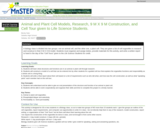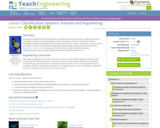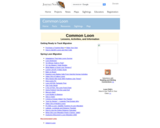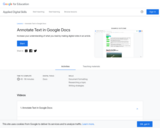
Can you guess the animal based on the clue? Try it out!
- Subject:
- Science
- Material Type:
- Activity/Lab
- Provider:
- COSI
- Provider Set:
- COSI Connects
- Author:
- COSI
- Date Added:
- 07/13/2021

Can you guess the animal based on the clue? Try it out!

This collection of images of six different creatures, including insects and carnivorous vertebrates, illustrates the wide range of mouth types that exist within the animal kingdom. It also discusses the environment and its impact on the evolution.

Use this guide to help you identify signs from different animals in the wilderness. Identify tracks, chew marks, signs from animals that build, eggs, and the like.

Learn about the structure and function of living organisms by drawing an imaginary animal in the Take the Stage game show, ANIMAL SURVIVAL! Viewers become contestants on a game show and are challenged to draw an imaginary animal that could live and survive in either the desert, ocean, or the arctic tundra. When drawing the imaginary animal, the contestants write out two distinct structures and a function for each of the structures that help it survive. Learning Objective: Compare the structures and functions of different species that help them live and survive in a specific environment.

Students build a 9 M X 9 M model of an animal or plant cell with cell organelles inside it and give cell tours to Life Science students. May be done as two large groups, or a whole class project.

A screencast tutorial which describes the major characteristics of animals with backbones called vertebrates. [1:38]

Students are introduced to the classification of animals and animal interactions. Students also learn why engineers need to know about animals and how they use that knowledge to design technologies that help other animals and/or humans. This lesson is part of a series of six lessons in which students use their growing understanding of various environments and the engineering design process, to design and create their own model biodome ecosystems.

Get information about a variety of mammals using this online alphabetical index. Information includes facts about their classification, habitat, diet, behavior and conservation status.

A short animated video demonstrating a few common simple and compound machines used doing yard work. [2:00]

Join teachers and students all over the country in observing the migratory patterns of birds and butterflies and the growth changes of plants as the climate changes. "Journey North" offers a wealth of resources to use as you investigate the causes and effects of seasonal change: maps, shared data from all over the country, migratory news, FAQs from experts, videos, and slide shows. You'll also learn how to track the coming of spring with your very own tulip study.

This lesson plan will help students explore adaptation, especially as it relates to migration. Students will come to realize that adaptations can be behavioral as well as physical. Students are assigned a particular animal to investigate and they consider all the adaptations that enable it to migrate.

A comprehensive resource that contains a number of facts about robins. In addition, there are challenge questions, lessons and activities to use in the classroom. The migration pattern is also tracked.

Find a collection of lessons, activities, and informative articles on the common loon.

Impressive animated slideshow presentation on the sun's daily cycle and how the sunlight changes hour by hour over the course of a day. Includes a teacher guide with lesson plan ideas and activities.

This is an appropriate resource for investigating the impact seasonal change has on organisms. Have your students track the changes that come with spring by journaling. The online table addresses physical changes in the environment (temperature, etc.) as well as changes in plants and animals.

Increase your understanding of what you read by making digital notes in an article. Time to complete: 45-90 minutes

This informational text explains that while both the Arctic and Antarctica are cold, Antarctica is much colder and drier - a polar desert. The text is written at a grade four through grade five reading level. This is a PDF containing the informational text and a glossary.

This video segment adapted from NOVA explains why ice sheets move. To find out how fast they move, scientists carve a tunnel through a glacier.

This video segment [3:33] adapted from NOVA explains why ice sheets move. To find out how fast they move, scientists carve a tunnel through a glacier.

What would happen if a portion of the Antarctic Ice Sheet were to melt? This video segment [3:19] adapted from NOVA uses animations to show the effect of a 6-meter sea-level rise on coastal cities across the world.